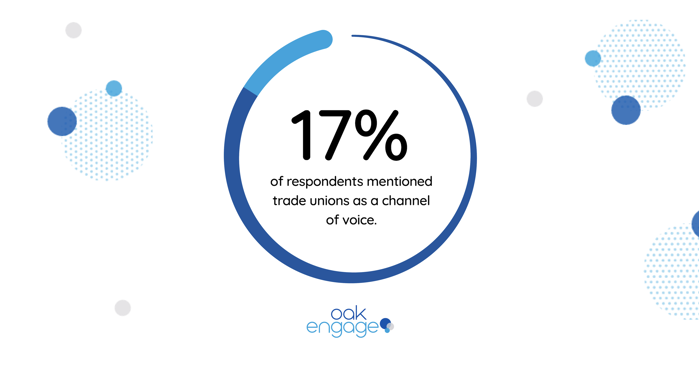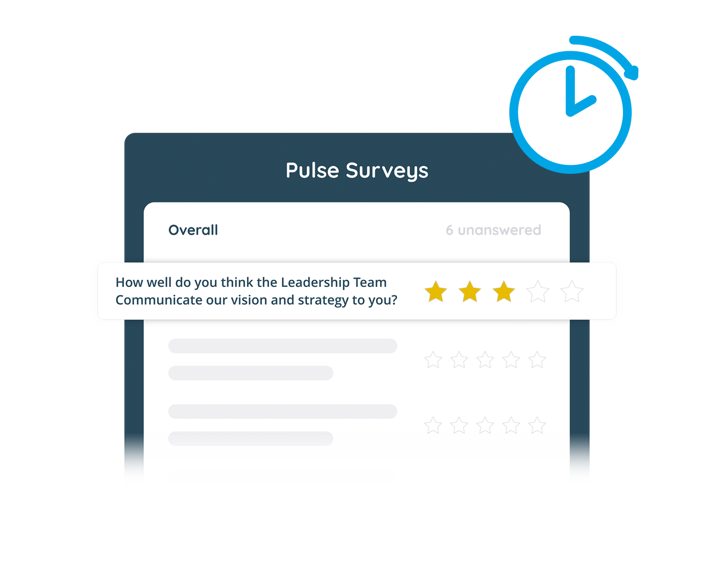“Recognising the importance of employee voice is vital if you want to facilitate prolonged and sustainable company growth. Encouraging an open, honest and transparent environment within your business is a prerequisite to creating a more positive and productive workplace. Champion your team and they will champion you.” Will Murray, CEO of Oak Engage
Do your employees believe they have a voice in the workplace?
Employees want their opinions and concerns to be heard at a strategic level, but there's no one-voice-fits-all method.
For employers, employee voices come with higher levels of innovation and productivity – not to mention the added benefits of improved organisational procedures. For staff, it can lead to an increase in job satisfaction and a greater influence on the way in which they work. We're experts on employee voice, we provide businesses around the world with the tools to empower their people and facilitate a two-way conversation. We know how powerful employee voice can be, that's why we've written this blog to help you and your businesses supercharge your internal communication strategy.
In this blog we’ll cover:
- What is Employee Voice?
- Importance of Employee Voice in the Workplace
- Employee Voice Examples
- Employee Voice Tools
- The Benefits of Employee Voice to your Employees
- The Benefits of Employee Voice to your Organisation
- How to Encourage Employee Voice in the Workplace
What Is Employee Voice?
Employee voices are essential where an organisation sees its people not as the problem, but rather the central to the solution. They want their people to be involved, listen to and invited to contribute their experience, expertise and ideas.
Employee voice exists when:
- Communication tools have been put in place to enable employees to have ongoing conversations in different ways, to ensure every voice is heard.
- Everyone in the company feels they can have a say and that their voice is heard and listened to. Their views are also taken into account when decisions are being discussed that affect them.
A History of Employee Voice
Since the early 1980s there's been a decline in trade union representation across various European countries, including the UK. Overall, there's less reliance on collective agreements as a means of influencing employment relationships.
CIPD produced a survey that found that only 17% of respondents mentioned trade unions as a channel of voice. The most common channel was one-to-one meetings with a manager. This reflects a shift away from indirect voice and instead leans towards direct and individual channels.

Importance of Employee Voice in the Workplace
Research suggests that a key indicator of organisational success is a company’s ability to make their employees feel heard.
Giving employees a voice is a critical component of establishing a workforce that is happy, more productive and engaged. However, employees must be convinced that their suggestions play an integral role in decision making. They will then become willing to communicate ideas, concerns and opinions within their role. If employees don't have a voice in the workplace, it can cause big problems as leaders often need their employees to raise issues that may otherwise be overlooked.
When you’re not heard, you just do what you’re told without questioning or offering to speak up and change things because you don't think anything will happen. This will cause overall disengagement and poor company culture.
Employee Voice Examples
As discussed, employee voice is fundamental to organisational success in the modern world. With that in mind, let's look at 5 ways in which companies can start activating employee voice and keep it working long-term:
1. Prioritise Making Employees Feel Safe
Giving feedback can make employees feel psychologically safe. This is defined by a perceived high level risk to areas such as staff wellbeing, social standing and in-or-out group status. With these risks, it's easier for people to stay silent. This can be difficult to overcome, but the good news is that managers can easily take action.
Recommended Reading 📖 Employee Wellbeing: A Beginners Guide
Leaders should be aware of how they come across to their employees. For example, certain types of body language can make them feel unsafe and uneasy. Furthermore, making it clear how you will protect employees in the way you present their feedback can make them feel safer voicing their opinions.
2. Ensure Leaders Set the Right Tone
Usually, senior leaders interact with their workforce less often than managers, so their impact on employee voice is normally indirect. Highly centralised decision-making combined with the lack of face-to-face interaction with employees may lead to employee opinions not being valued or considered when leaders make decisions.
Therefore, it’s important that senior leaders ensure that employee voice mechanisms are built into the decision-making process. Having an employee representative could help spread the right opinions, this is something organisations could think about including in their company culture.
3. Encourage More Employee-Centred Leadership
Organisations with traditional leadership styles could benefit from employee-centered styles in their planning strategies. Leadership development programmes could also be implemented to encourage employee voice.

Employee voice tends to be brought to the surface when employees are able to feel honest and true to themselves. By role modelling individuality through authenticity, leaders suggest that having opinions and voicing them are desirable behaviours to have.
4. Provide Information to Employees in the Right Way
When senior leaders are perceived as being ‘better’ than their employees and keeping information to themselves, it is unfair to expect employees to develop a strong company voice.
Leaders need to value their workforce and encourage company culture by sharing decisions, organisational changes and challenges. This information should be shared via your company intranet and feedback should be encouraged.
5. Encourage Leaders to Participate in Trust-Building Conversations
Even leaders who pride themselves on having an ‘open door’ policy find it hard to get honest answers from employees. This may be due to the mismatch in power and authority.
Encouraging middle managers to hold information conversations and listening more are actions which organisations can take in order to address these issues.
Employee Voice Tools
We’ve discussed the impact that poor employee voice can have on an organisation, so let's have a look at the list of tools that companies can use to encourage employee voice.
Surveys and Polls
Pulse Surveys are used to gather real, actionable insights that businesses can use to improve employee engagement, collaboration and enhance employee experience.
They are a great starting point to allow your business to gauge interest, understand an employee's opinion, gather feedback and more.

Communication Initiatives
Alongside surveys, there are a number of communication initiatives you could introduce. You should consider things like:
- Open meetings
- Suggestion boxes
- Idea walls
- Forums
- Nominating employee representatives
- Run focus groups
The Benefits of Employee Voice to Your Employees
You know how important employee voice can be in general. But what about the benefits of your employees within the workplace?
Develops Individuals
When people feel like they can speak up in the workplace, it not only helps them develop their own confidence but it gives them the chance to find out the best ways to develop their skills within their role.
When they feel like they can ask for training or help with a task, it will only help them to improve their own work, as well as the company as a whole.
Increases Focus
If employees have a positive experience when they speak up about their opinion, it’s going to go a long way in helping them to concentrate on their work.
They know that their problems are being solved therefore they will spend less time worrying and can commit fully to their work at hand.
Reduces Negatives Attitudes
A negative atmosphere can occur if employees feel like their problems aren't being solved or their voices aren't being heard.
However, when they feel like they can speak openly to their managers, they’re much less likely to be negative both internally and externally.
Increases Workplace Happiness
When employees feel like their voices are being heard and their company is willing to act and not just listen, people will feel much happier in their role and working for the organisation.
Feel More Supported
Listening and willing to act is met with great support between managers and employees. This will greatly improve the overall working environment for workforces.
The Benefits of Employee Voice to Your Organisation
We’ve covered the benefits that employee has for your employees, but what does this mean for your organisation?
Employee Voice & Organisation Performance
Detert and Burris (2012) found a positive relationship between transformational leadership and employee voice, while Walumbwa and Schaubroeck (2009) found the same positive relationship between ethical leadership and employee voice. Finally, Hsin-Hua Hsiung (2011) found a positive relationship between authentic leadership and employee voice.
As soon as an organisation invests in their employees, how they're feeling and deal with their concerns, the performance of your workforce increases. This has a domino effect on your organisation performance. Sales start to increase, revenue goes up and company culture skyrockets.
Employee Voice & Employee Engagement
Allowing employees to talk openly displays a level of trust which leads to employees feeling more values and connected to leads as well as other employees.
This is why the UK’s Engage for Success movement defines employee voice as one of their four main enablers of employee engagement and there is plenty of evidence on the movement’s website showing how engagement leads to higher productivity, improved innovation and a raft of other benefits.
Employee Voice & Employee Retention
If a company is willing to develop people based on their feedback, change work processes, improve company culture, listen to views and improve your employees experience then they will be more willing to stay with the company long-term.
How to Encourage Employee Voice in the Workplace
Start With Leaders
In order to establish a foundation of trust and confidence, you need to start with the company leaders. An employee’s experience is only as good as their manager and for some organisations, many higher ups may not engage with employees at all.
You should start by facilitating conversations with employees and develop a transparent culture.
Ensure Employees Are Informed
Ensure to share key company information and keep them in the loop as much as possible. This can be done through weekly meetings, performance reviews, emails or company intranets.
Create a Culture of Openness and Feedback
Enabling a culture of openness and inclusivity allows you to develop a wealth of knowledge and discover solutions to solve internal problems.
There are a variety of ways you could encourage feedback within your company, however it should never be confined to one channel.
Employee Voice and Organisation Performance
Employee voice plays a crucial role in influencing organisation performance. When employees feel empowered and encouraged to express their ideas, concerns, and feedback openly, it leads to several positive outcomes that contribute to the overall success of the organisation.
Firstly, employee voice fosters a culture of engagement and commitment. When employees know that their opinions are valued and listened to, they are more likely to feel invested in the success of the company. This increased engagement translates into higher levels of productivity and a willingness to go above and beyond to achieve organisational goals.
Secondly, employee voice enhances decision-making processes. By encouraging diverse perspectives and ideas, organisations can make more informed and well-rounded decisions. Employees, being the ones directly involved in day-to-day operations, often possess valuable insights that leaders may not be aware of. By tapping into this collective knowledge, organisations can make better choices and adapt more effectively to changes in the market.
Furthermore, employee voice contributes to innovation and creativity. When employees feel comfortable sharing their innovative ideas, it leads to a culture of continuous improvement and experimentation. This can result in the development of new products, services, or processes, giving the organisation a competitive edge and positioning it as a market leader.
Moreover, an environment that encourages employee voice improves employee satisfaction and retention. When employees see that their opinions matter and that they have a voice in shaping the organisation, they are more likely to stay committed to the company for the long term. This reduces turnover rates and saves on recruitment and training costs.
Overall, employee voice is closely linked to organisation performance. It drives engagement, enhances decision-making, sparks innovation, and improves employee satisfaction. Organsations that prioritise and actively seek out employee input are more likely to thrive and remain competitive in today's dynamic business landscape.
Oak Engage - Giving Employees a Voice Everywhere
In the fast-paced and ever-evolving world of business, fostering a culture that values and amplifies employee voice has become more crucial than ever. With the rise of innovative technologies, companies now have unprecedented opportunities to embrace open communication and empower their workforce to contribute meaningfully to the organisations growth. Enter Oak Engage – an innovative and slick platform designed to revolutionise the way companies approach employee voice. This cutting-edge tool offers a seamless and intuitive experience, creating an environment where every team member feels heard, valued, and encouraged to share their insights
As the business landscape continues to evolve, it is increasingly clear that companies that prioritise employee voice gain a competitive edge by harnessing the collective intelligence of their workforce. Oak Engage not only facilitates open dialogue between employees and management but also creates a sense of ownership and camaraderie among team members, as their contributions are actively acknowledged and implemented.
Moreover, Oak Engage's user-friendly interface and diverse range of features make it accessible to all, regardless of their role or level within the organisation. From offering anonymous feedback channels to providing real-time pulse surveys, Oak fosters a culture of trust and transparency, breaking down hierarchical barriers and promoting a sense of belonging.
Through Oak Engage companies can cultivate a workplace culture that not only embraces innovation and creativity but also boosts employee engagement and satisfaction. Empowered employees are more likely to be motivated, loyal, and invested in the organisations success, resulting in increased productivity and improved overall performance.


![Employee Voice In The Workplace [Ultimate Guide]](/media/ezyh3kvz/employee-voice-header.png?width=50)

